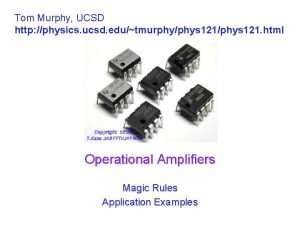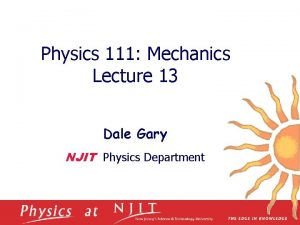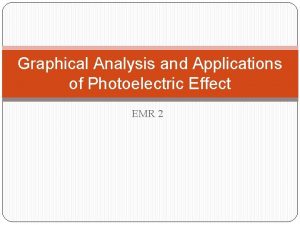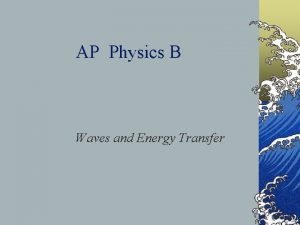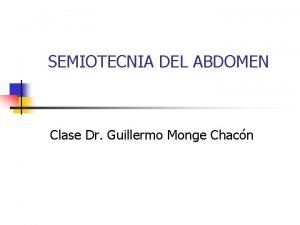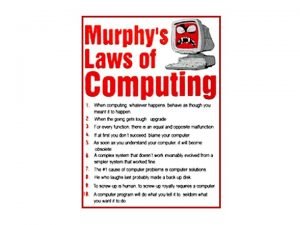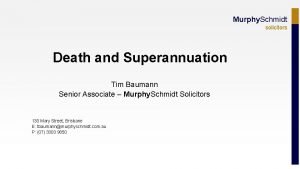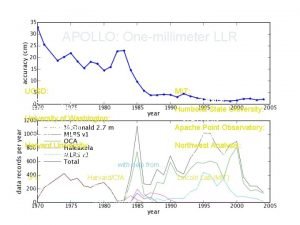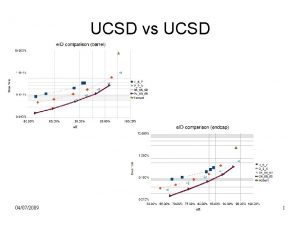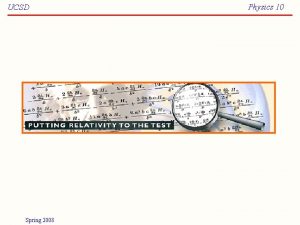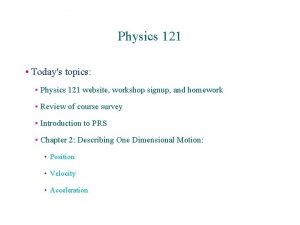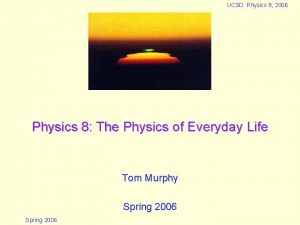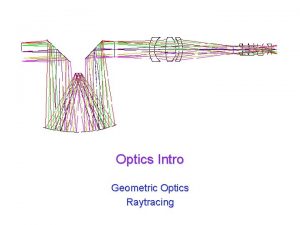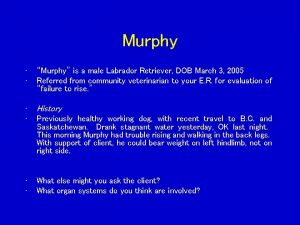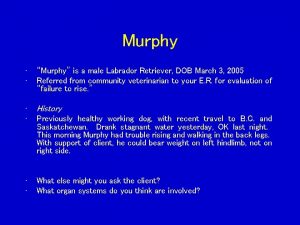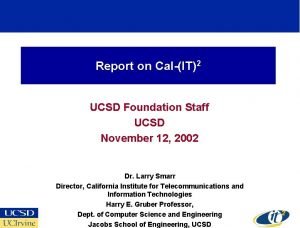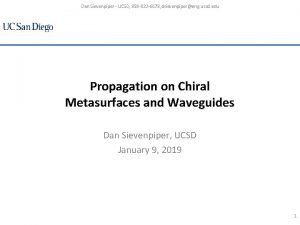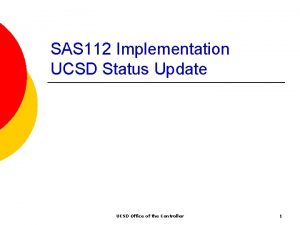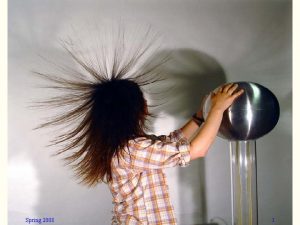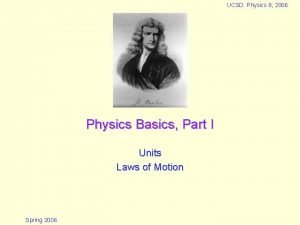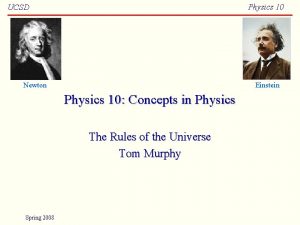Tom Murphy UCSD http physics ucsd edutmurphyphys 121





























- Slides: 29

Tom Murphy, UCSD http: //physics. ucsd. edu/~tmurphy/phys 121. html Operational Amplifiers Magic Rules Application Examples

UCSD: Physics 121; 2012 Op-Amp Introduction • Op-amps (amplifiers/buffers in general) are drawn as a triangle in a circuit schematic • There are two inputs – inverting and non-inverting • And one output • Also power connections (note no explicit ground) divot on pin-1 end V+ inverting input non-inverting input 2 3 7 6 + output 4 V Winter 2012 2

UCSD: Physics 121; 2012 The ideal op-amp • Infinite voltage gain – a voltage difference at the two inputs is magnified infinitely – in truth, something like 200, 000 – means difference between + terminal and terminal is amplified by 200, 000! • Infinite input impedance – no current flows into inputs – in truth, about 1012 for FET input op-amps • Zero output impedance – rock-solid independent of load – roughly true up to current maximum (usually 5– 25 m. A) • Infinitely fast (infinite bandwidth) – in truth, limited to few MHz range – slew rate limited to 0. 5– 20 V/ s Winter 2012 3

op amp: modello 4

UCSD: Physics 121; 2012 Op-amp without feedback • The internal op-amp formula is: Vout = gain (V+ V ) • So if V+ is greater than V , the output goes positive • If V is greater than V+, the output goes negative V V+ + Vout • A gain of 200, 000 makes this device (as illustrated here) practically useless Winter 2012 5

UCSD: Physics 121; 2012 Infinite Gain in negative feedback • Infinite gain would be useless except in the selfregulated negative feedback regime – negative feedback seems bad, and positive good—but in electronics positive feedback means runaway or oscillation, and negative feedback leads to stability • • • Imagine hooking the output to the inverting terminal: If the output is less than Vin, it shoots positive If the output is greater than Vin, it shoots negative – result is that output quickly forces itself to be exactly Vin Winter 2012 negative feedback loop + 6

UCSD: Physics 121; 2012 Even under load • Even if we load the output (which as pictured wants to drag the output to ground)… – the op-amp will do everything it can within its current limitations to drive the output until the inverting input reaches Vin – negative feedback makes it self-correcting – in this case, the op-amp drives (or pulls, if Vin is negative) a current through the load until the output equals Vin – so what we have here is a buffer: can apply Vin to a load without burdening the source of Vin with any current! Vin Winter 2012 + Important note: op-amp output terminal sources/sinks current at will: not like inputs that have no current flow 7

UCSD: Physics 121; 2012 Positive feedback pathology • In the configuration below, if the + input is even a smidge higher than Vin, the output goes way positive • This makes the + terminal even more positive than Vin, making the situation worse • This system will immediately “rail” at the supply voltage – could rail either direction, depending on initial offset Vin + Winter 2012 positive feedback: BAD 8

feedback Vin V’ Vout A 0 B 9

UCSD: Physics 121; 2012 Op-Amp “Golden Rules” • When an op-amp is configured in any negativefeedback arrangement, it will obey the following two rules: – The inputs to the op-amp draw or source no current (true whether negative feedback or not) – The op-amp output will do whatever it can (within its limitations) to make the voltage difference between the two inputs zero Winter 2012 10

UCSD: Physics 121; 2012 Inverting amplifier example R 2 R 1 Vin + Winter 2012 Vout 11

UCSD: Physics 121; 2012 Inverting amplifier example R 2 R 1 Vin + Vout • Applying the rules: terminal at “virtual ground” – so current through R 1 is If = Vin/R 1 • Current does not flow into op-amp (one of our rules) – so the current through R 1 must go through R 2 – voltage drop across R 2 is then If. R 2 = Vin (R 2/R 1) • So Vout = 0 Vin (R 2/R 1) = Vin (R 2/R 1) • Thus we amplify Vin by factor R 2/R 1 – negative sign earns title “inverting” amplifier • Current is drawn into op-amp output terminal Winter 2012 12

UCSD: Physics 121; 2012 Non-inverting Amplifier R 2 R 1 Vin Winter 2012 + Vout 13

UCSD: Physics 121; 2012 Non-inverting Amplifier R 2 R 1 Vin + Vout • Now neg. terminal held at Vin – so current through R 1 is If = Vin/R 1 (to left, into ground) • This current cannot come from op-amp input – – – so comes through R 2 (delivered from op-amp output) voltage drop across R 2 is If. R 2 = Vin (R 2/R 1) so that output is higher than neg. input terminal by Vin (R 2/R 1) Vout = Vin + Vin (R 2/R 1) = Vin (1 + R 2/R 1) thus gain is (1 + R 2/R 1), and is positive • Current is sourced from op-amp output in this example Winter 2012 14

Noninverting amplifier Voltage follower Ref: 080114 HKN Noninverting input with voltage divider Less than unity gain Operational Amplifier 15

Ideal Vs Practical Op-Amp Ideal Practical Open Loop gain A 105 Bandwidth BW 10 -100 Hz Input Impedance Zin >1 M 0 10 -100 Output Impedance Zout Output Voltage Vout CMRR Ref: 080114 HKN Depends only on Vd = (V+ V ) Differential mode signal Depends slightly on average input Vc = (V++V )/2 Common-Mode signal 10 -100 d. B Operational Amplifier 16

UCSD: Physics 121; 2012 Summing Amplifier Rf R 1 V 1 R 2 V 2 + Vout • Much like the inverting amplifier, but with two input voltages – inverting input still held at virtual ground – I 1 and I 2 are added together to run through Rf – so we get the (inverted) sum: Vout = Rf (V 1/R 1 + V 2/R 2) • if R 2 = R 1, we get a sum proportional to (V 1 + V 2) • Can have any number of summing inputs – we’ll make our D/A converter this way Winter 2012 17

UCSD: Physics 121; 2012 Differencing Amplifier R 2 R 1 V + V+ Vout R 1 R 2 • The non-inverting input is a simple voltage divider: Winter 2012 18

UCSD: Physics 121; 2012 Differencing Amplifier R 2 R 1 V + V+ Vout R 1 R 2 • The non-inverting input is a simple voltage divider: – Vnode = V+R 2/(R 1 + R 2) Winter 2012 19

UCSD: Physics 121; 2012 Differencing Amplifier R 2 R 1 V + V+ Vout R 1 R 2 • The non-inverting input is a simple voltage divider: – Vnode = V+R 2/(R 1 + R 2) • So If = (V Vnode)/R 1 Winter 2012 20

UCSD: Physics 121; 2012 Differencing Amplifier R 2 R 1 V + V+ Vout R 1 R 2 • The non-inverting input is a simple voltage divider: – Vnode = V+R 2/(R 1 + R 2) • So If = (V Vnode)/R 1 – Vout = Vnode If. R 2 = V+(1 + R 2/R 1)(R 2/(R 1 + R 2)) V (R 2/R 1) Winter 2012 21

UCSD: Physics 121; 2012 Differencing Amplifier R 2 R 1 V + V+ Vout R 1 R 2 • The non-inverting input is a simple voltage divider: – Vnode = V+R 2/(R 1 + R 2) • So If = (V Vnode)/R 1 – Vout = Vnode If. R 2 = V+(1 + R 2/R 1)(R 2/(R 1 + R 2)) V (R 2/R 1) – so Vout = (R 2/R 1)(V V ) Winter 2012 22

Differentiator (high-pass) C Vin R Vout 23

UCSD: Physics 121; 2012 Differentiator (high-pass) R C Vin + Vout • For a capacitor • So we have a differentiator, or high-pass filter Winter 2012 24

UCSD: Physics 121; 2012 Low-pass filter (integrator) C R Vin + Vout • If = Vin/R, so C·d. Vcap/dt = Vin/R – and since left side of capacitor is at virtual ground: – and therefore we have an integrator (low pass) Winter 2012 25

esempio: 741 26

Frequency-Gain Relation • • • Ideally, signals are amplified from DC to the highest AC frequency Practically, bandwidth is limited 741 family op-amp have an limit bandwidth of few KHz. 20 log(0. 707)=3 d. B Unity Gain frequency f 1: the gain at unity Cutoff frequency fc: the gain drop by 3 d. B from dc gain Gd GB Product : f 1 = Gd fc Ref: 080114 HKN Operational Amplifier 27

GB Product Example: Determine the cutoff frequency of an op-amp having a unit gain frequency f 1 = 10 MHz and voltage differential gain Gd = 20 V/m. V Sol: ? Hz Since f 1 = 10 MHz By using GB production equation f 1 = Gd f c fc = f 1 / Gd = 10 MHz / 20 V/m. V 10 MHz = 10 106 / 20 103 = 500 Hz Ref: 080114 HKN Operational Amplifier 28

Gain-Bandwidth product: GBP = Ao BW
 Ucsd physics
Ucsd physics Fermi estimation
Fermi estimation Tom murphy ucsd
Tom murphy ucsd Lisa murphy ucsd
Lisa murphy ucsd Physics 121 njit
Physics 121 njit Njit physics
Njit physics Tom tom go 910
Tom tom go 910 The devil and tom walker symbols
The devil and tom walker symbols Ucsd physics courses
Ucsd physics courses Ucsd physics courses
Ucsd physics courses Phys courses ucsd
Phys courses ucsd Tom and jerry bad physics
Tom and jerry bad physics Http //mbs.meb.gov.tr/ http //www.alantercihleri.com
Http //mbs.meb.gov.tr/ http //www.alantercihleri.com Http //siat.ung.ac.id atau http //pmb.ung.ac.id
Http //siat.ung.ac.id atau http //pmb.ung.ac.id Http://www.kcvs.ca/site/projects/physics.html
Http://www.kcvs.ca/site/projects/physics.html Http://www.colorado.edu/physics/phet
Http://www.colorado.edu/physics/phet Why does it happen
Why does it happen University physics with modern physics fifteenth edition
University physics with modern physics fifteenth edition Ia topics for physics
Ia topics for physics Suction splash
Suction splash Percusion renal
Percusion renal Semnul bulgarelui de gheata
Semnul bulgarelui de gheata Maniobra de la mano de escultor de merlo
Maniobra de la mano de escultor de merlo Percusion abdomen
Percusion abdomen Kevin murphy nasa
Kevin murphy nasa Murphy's law computers
Murphy's law computers Murphy's committee
Murphy's committee Murphy schmidt
Murphy schmidt Murphy schmidt
Murphy schmidt Kolanjit charcot triadı
Kolanjit charcot triadı
